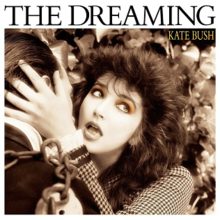 Ask people to come up with a word to describe Kate Bush and you’ll get many answers. She once described herself as: “the shyest megalomaniac you’re ever likely to meet.” I asked a number of friends to give me three words to describe her and hardly any gave me the same answer. So here, plagiarising heavily the title of her most recent album, are 50 words for Kate Bush…
Ask people to come up with a word to describe Kate Bush and you’ll get many answers. She once described herself as: “the shyest megalomaniac you’re ever likely to meet.” I asked a number of friends to give me three words to describe her and hardly any gave me the same answer. So here, plagiarising heavily the title of her most recent album, are 50 words for Kate Bush…
Startling, unforgettable, unexpected, melodramatic
Forty-three years ago, January 1978, the haunting ethereal vocals of Wuthering Heights poured out on the radio waves for the very first time. Written in one night, by the light of the full moon after she caught part of a BBC dramatisation on TV, the world had heard nothing quite like it. Initially dismissed as a novelty by the earnest music press, it quickly rose in popularity, radio play and sales. Her appearance on Top of The Pops and those unforgettable dance moves worked their magic. It hit the number one spot in just three weeks and stayed there for four more. It went on to be a top twenty hit in sixteen other countries and number one in five. The single finished the year as the tenth highest selling and was certified gold, denoting sales of over half a million. Worldwide sales topped a million. Kate Bush hadn’t so much arrived on the music scene as exploded.
Inspirational, visionary
There is no doubt Kate has inspired and influenced many other artists. St. Vincent and Adele have publicly expressed how her music influenced their own work. Prince, Peter Gabriel, and Elton John have all worked with her (the latter even asked her to his wedding – speaking later he said that amongst 600 guests, she was the only one anyone was interested in). Sex Pistol John Lydon said a lot of his friends at the time couldn’t bear Bush’s high-pitched, passionate warbling on Wuthering Heights and other early songs. “They just thought it was too much but that was really what drew me in.” Even Tupac was a Kate Bush fan.
Innovative, groundbreaking, experimental, progressive
She has trialled the use of new technology throughout her work. Once she had been introduced to the Fairlight computer (by Peter Gabriel) she used the computer generated sounds all her work. She can also be credited with discovering the headset mic, now ubiquitous in live performance. For her famous live tour in 1979 she wanted to dance as she sang, so she fashioned a headset microphone from a wire clothes hanger, making her the first singer to use such a device on stage. She is also no stranger to using unusual instruments and vocal techniques. The Dreaming, for example, uses many folk instruments such as mandolins, uilleann pipes and even didgeridoos. On The Sensual World she used the Trio Bulgarka, a Bulgarian vocal ensemble, to create a unique sound.
Creative, perfectionist
Kate Bush began writing songs at the age of eleven. The Man With The Child In His Eyes, her second hit, was penned when she was just thirteen. It is clear that right from the very beginning, all her songs are very carefully crafted works of art. In an interview in Mojo magazine, she discussed her creative process: “I don’t like working in commercial studios… I don’t like the dissipation of the focus. ‘Cos you might be in the middle of doing a vocal and you look through to the control room and you’ll see somebody walking in looking for a pair of headphones or something. I think it’s very important to get the creative focus and it’s very easy to be distracted. The creative process is, I think, very much about trying to keep this focus throughout all these things that are trying to destroy it… It [her personal studio] is a quiet space that you create from. I think of it quite often as being similar to people who write books… it’s disciplined”. Sometimes, though, inspiration just strikes. As well as Wuthering Heights, Kate claims her other massive hit, Running Up That Hill, was reportedly written in one evening in the summer of 1983 and This Woman’s Work, “was a very easy song to write. It was very quick. And just kind of came, like a lot of songs do.”
Feminine, powerful, mother
A great deal of Kate’s work has a particular sense of the female about it. She discussed this herself on the release of The Sensual World album: “I just felt that I was exploring my feminine energy more – musically. In the past I had wanted to emanate the kind of power that I’ve heard in male music. And I just felt maybe somewhere there is this female energy that’s powerful”. Her use of Trio Bulgarka also had effect: “She said: “Suddenly, there I was working with these three ladies from a completely different culture. I’ve never worked with women on such an intense creative level, and it was something strange to feel this very strong female energy in the studio. It was interesting to see the way the men in the studio reacted to this. Instead of just one female, there was a very strong female presence.”
Motherhood also features prominently in her work, referenced in lyrics like ‘Mother stands for comfort’ but also vividly referenced in specific songs. Army Dreamers is about a grieving mother who through the death of her soldier son, questions her motherhood. Breathing is about a foetus, very much aware of what is going on outside the womb and frightened by nuclear fallout.
Literary, erudite, storyteller, diverse
Wuthering Heights was just the beginning of a career that has been filled with literary influences. Bush has drawn inspiration for her own work from almost every possible source. Her fourth album The Dreaming uses a variety of sources, including old crime films, a documentary about the Vietnam War, the plight of indigenous Australians, the life of Houdini and the Stephen King novel The Shining (on closing track Get Out Of My House). Peter Pan by J.M. Barrie features heavily in Lionheart – the children’s character appearing in two songs on the album, In Search of Peter Pan and Oh England My Lionheart, where she sings about the things she associates with England, including Peter Pan and Shakespeare. Shakespeare appears briefly again on her third album, Never For Ever where she quotes Othello in Blow Away. Cloudbusting was inspired by A Book of Dreams by Peter Reich. The title of the second half of Hounds of Love, The Ninth Wave, comes from a poem by Tennyson The Coming of Arthur, from Idylls of the King. On The Sensual World, its title track was based on the closing passage of James Joyce’s Ulysses. The Red Shoes is based on the film of the same name which was inspired by a fairytale by Hans Christian Anderson. Fittingly, her recently released book of lyrics, called How To Be Invisible sits on the shelf as a beautifully bound slim volume of poetry.
Haunting, spooky, strange, magical, ethereal, surreal, melancholic, dark
From the initial ghostly cries of Catherine Earnshaw in Wuthering Heights, the spiritual world is never far away from her work. There are obvious references, such as Hammer Horror and the unseen shadow trying desperately to communicate in Watching You Without Me but scratch below the surface and you will find other supernatural references in much of her work taken from both literary and film references. The title track Hounds of Love starts with a quote from the horror film Night of The Demon by Maurice Denham. It was Werner Herzog’s use of the haunting Georgian folksong Tsintskaro in his 1979 remake of Nosferatu that inspired her to use the same song in Hello Earth, on the Hounds of Love album. In another song on Never For Ever, called The Infant Kiss, Bush sings about the haunting 1961 ghost film The Innocents (the film is based on Henry James’s Victorian ghost novel, The Turn of the Screw, which tells the story of a governess who becomes convinced that the house she is teaching in is haunted). Her most recent album, 50 Words For Snow features Lake Tahoe, in which a ghostly Victorian woman still searches for her dog and Get Out Of My House, from The Dreaming, is said to have been inspired by Stephen King’s The Shining. There are occult references in her work too. Lily, from the Red Shoes begins with a protection spell and the chorus features the incantation “Gabriel before me, Raphael behind me, Michael to my right, Uriel on my left side”, invoking protection from the archangels. Waking the Witch, (Hounds of Love) on the other hand, deals more with the persecution of witches rather than mythology or methodology. Bush also sings about extra-sensory perception in Strange Phenomena on The Kick Inside and the Yeti in Wild Man from 50 Words for Snow.
Willowy, mesmerising, acrobatic, avant-garde, theatrical, wild, artistic, kooky
When the teenage Kate Bush received her first contract advance, she famously spent the money on mime and movement lessons from Lindsay Kemp who had also worked with David Bowie. Speaking about him she said: “I couldn’t believe how strongly Lindsay communicates with people without even opening his mouth. It was incredible, he had the whole audience in his control, just with his little finger. And it was amazing. I’d never seen anything like it, I really hadn’t…I realised there was so much potential with using movement in songs.” Kemp said of her she began: “as timid as hell..[but] once Kate actually started dancing, she was wild”. It is no surprise, then, that movement and dance have featured prominently in both music videos and live performance. Her 1979 live tour was acclaimed for the incorporation of mime, magic, and readings during costume changes. Her 2014 live residency at the Hammersmith Apollo Before The Dawn was also no ordinary live gig. Instead the audiences were stunned by a multi-media performance involving dancers, puppets, shadows, masks, 3D animation and an illusionist. Bush herself spent three days in a flotation tank for filmed scenes that were played during the performance. But it will always be her initial appearance on the Wuthering Heights video that will be most remembered. It is so iconic that in 2018 hundreds of Kate Bush fans gathered across the world to recreate her video in celebration of the song’s 40th birthday.
Sexy, beautiful, gorgeous, stunning, enchanting
Throughout her career, Bush has been very honest about her approach to sex and sensuality which features heavily in her work. In an interview in 1979, she said: “Most of the pop songs today are about sex whether they say it obviously or not. For years the subject has been to write about boy meets girl”. On being asked if people see her as a sex symbol she replies: “they do but as long as people appreciate me as a musician, as an artist, then it’s great. If anything comes in on top of that, that’s a bonus. I am a serious artist, I’m not just flirting around with business.”
As Graeme Thomson notes in his biography Under The Ivy: The Life & Music of Kate Bush: “right from her first single…there was a skewing away from the brilliance of her music – by some people – to what Bush looked like and how she was some kind of temptress…Bush is a beautiful woman …but she was never marketing herself as a femme fatale or this edgy and sexualised Pop artist”. There is a much wider debate to be had about the sexualisation of women (and men) in the pop industry, particularly how they are marketed, which still is very evident today. It is clear from her very earliest interviews that Kate always cared less about the adulation than she did about the music. That she is gorgeous is without doubt, but that was never what it was about for her.
Reclusive, private, enigmatic, mysterious
In 1979 the world first got to see Kate Bush live. The tour was a critical and commercial success but she chose not to do any live gigs again for 35 years. She never fully explained her reluctance to perform live but complained that touring was exhausting and also alluded, in subsequent interviews, to possible stage-fright: “I do have the odd dream where I’m on stage and I’ve completely forgotten what I’m meant to be performing – so they are more nightmares than dreams.” Added to this, after the first initial flush of album releases, were the increasingly long gaps between new work. After the release of The Red Shoes, she dropped out of the public eye completely. It has been said she originally intended to take just one year off, but despite apparently working on material, twelve years passed before her next album. Her name occasionally cropped up in the media with rumours of new work but time and again they amounted to nothing. The press seemed to view her now as an eccentric recluse. Others thought motherhood had changed her priorities after she gave birth to her son Bertie in 1998. Right from the beginning, however, in an interview in 1979, it was clear where her priorities lay with regards to self-preservation: “It’s the rule of life. You have to look after yourself. I’m really determined to stay a human being, whatever happens to me, I’m going to stay real as a person”. Clamour as they may, the fans will always have to be content to wait.
Successful, talented, incredible, amazing, unique
Wuthering Heights, her debut single, written when she was only eighteen, was the first time a song both written and performed by a woman had reached number one in the charts. In 2014, bolstered by the immense publicity around the live dates Before the Dawn, Bush became the first female performer ever to have eight albums in the UK Top 40 Albums Chart simultaneously. The only artists ahead of her were Elvis and The Beatles. Kate Bush has a very secure place in musical history.
Over the years, she has been nominated for 13 British Phonographic Industry accolades – winning for Best British Female Artist in 1987 – and has been nominated for three Grammy Awards. In 2002, Bush was recognised with an Ivor Novello Award for Outstanding Contribution to British Music. In 2017, she was nominated for induction in the 2018 Rock and Roll Hall of Fame. Bush was appointed Commander of the Order of the British Empire (CBE) in the 2013 New Year Honours for services to music.
Original
When she won the Ivor Novello Award, Fellow of the Academy David Arnold said, “I’ve not met an artist in the 30 years of working in music who doesn’t love Kate Bush. Since she emerged, seemingly fully formed as an artist in the 1970s, she immediately claimed a place in the arts as a true original with a raw, pure, visionary talent.
“A writer who pushed the boundaries of what songwriting could be, a producer showing us how exciting and challenging the sound of a record could be and a performer who mesmerised, enchanted and drew her audience in to the worlds she had so beautifully and fully created.
“The fact she is still such an influence on so many established and emerging artists tells you all you need to know about how very precious and appreciated she is.
“I am thankful for her work and her kindness and it’s very right and proper that she has been named as a Fellow of our Academy, we are lucky to have her.”
Indeed we are.




 Ask people to come up with a word to describe Kate Bush and you’ll get many answers. She once described herself as: “the shyest megalomaniac you’re ever likely to meet.” I asked a number of friends to give me three words to describe her and hardly any gave me the same answer. So here, plagiarising heavily the title of her most recent album, are 50 words for Kate Bush…
Ask people to come up with a word to describe Kate Bush and you’ll get many answers. She once described herself as: “the shyest megalomaniac you’re ever likely to meet.” I asked a number of friends to give me three words to describe her and hardly any gave me the same answer. So here, plagiarising heavily the title of her most recent album, are 50 words for Kate Bush…
Post comments (0)